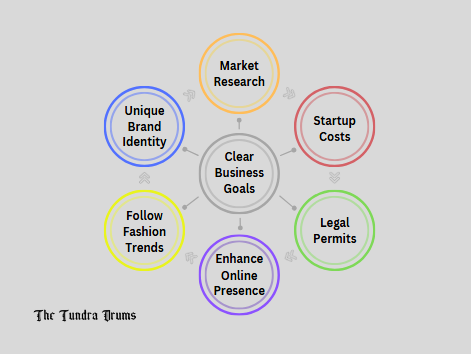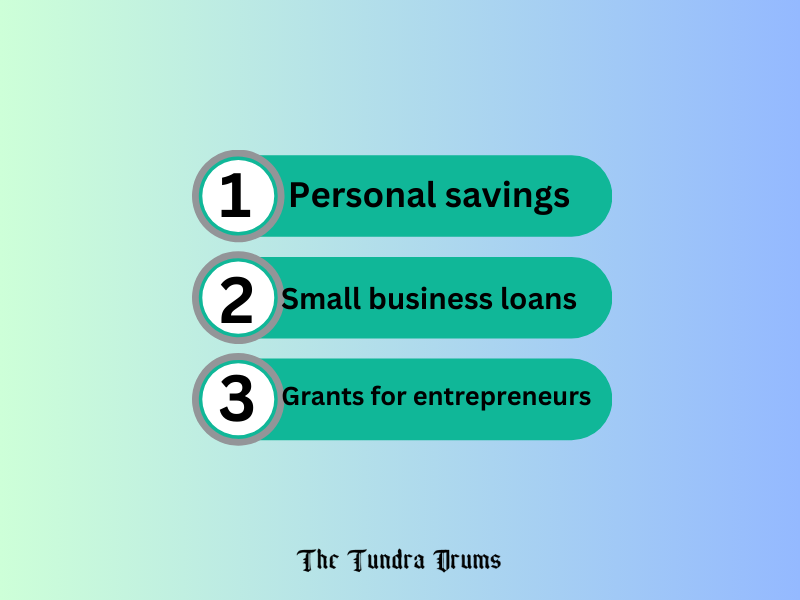Home-based clothing business allows you to reach a broad market while managing overhead costs. As of 2024, the global apparel market is valued at $1.79 trillion, and the demand for unique, trendy clothing continues to rise. In this guide, you will find how to start a small clothing business from home, and each step from market research to creating your brand identity to give you a clear path forward.
The global apparel industry accounts for 1.63% of the world’s GDP, and in the U.S. alone, it’s valued at $358.70 billion. This booming industry offers significant opportunities for entrepreneurs looking to create unique clothing lines.
How to Start a Small Clothing Business From Home?

1. Market Research and Identifying a Niche:
Research is necessary. The U.S. apparel market generates monthly retail sales of around $25.63 billion, with peaks such as April 2024 reaching $25.84 billion. Given this demand, analyzing trends is essential. In 2024, spring/summer trends include high-rise trousers, transparent skirts, and polo club aesthetics, while autumn/winter brings tonal dressing, barrel silhouettes, and suede styles. Finding a specific niche within these trends can help your brand stand out.
2. Setting Clear Business Goals:
Set both short-term and long-term goals to stay focused. For example, you may want to reach $10,000 in revenue within the first six months or sell a specific number of units in a targeted timeframe. With 58% of U.S. consumers still preferring to shop in-store, setting goals to tap into both online and offline segments can broaden your customer base.
3. Crafting a Unique Brand Identity:
Your brand identity should capture the essence of your clothing line. This includes a memorable name, logo, and brand story. The fashion industry’s anticipated retail sales growth of 2-4% in 2024 highlights a strong opportunity to capture customer attention with a unique, cohesive brand.
4. Fashion Trends for 2024 and How to Incorporate Them:
Fashion in 2024 reflects both nostalgia and functionality. Here’s a snapshot of the year’s key trends:
- Spring/Summer: High-rise trousers, transparent skirts, and ‘90s redux styles.
- Autumn/Winter: Tonal dressing, barrel silhouettes, and suede.
- Accessories and Footwear: Oversized bags and chunky knitwear.
- Colors: Crimson red and chocolate brown dominate, especially in autumn/winter styles.
Staying current with these trends while maintaining a unique style will help your brand appeal to fashion-conscious consumers.
5. Deciding on Business Model: Print-on-Demand vs. DIY Production:
Choose between two popular business models:
- Print-on-Demand (POD): The POD sector is projected to reach $10 billion by 2025. This low-risk model suits entrepreneurs who want to avoid holding inventory.
- DIY Production: Offers higher control over quality and design but requires upfront investment. Clothing items in this model typically aim for a profit margin between 30-50%.
Both models are viable; the choice depends on your budget and the level of control desired overproduction.
6. Designing and Sourcing Your Products:
Every year, over 100 billion garments are produced globally, averaging 12.5 pieces per person. With projected global consumption set to rise by 63% by 2030, there’s a growing demand for well-crafted, sustainable clothing. Make a partnership with reputable suppliers and ensure strict quality control to build brand trust.
7. Establishing Your Online Presence:
Your website is your storefront. Monthly retail sales of clothing in the U.S. are high, signaling demand. Use platforms like Shopify or Etsy, and optimize your site for SEO with keywords like “home-based clothing business.” An e-commerce site with a user-friendly experience will improve customer engagement and conversion rates.
8. Legal Requirements and Permits:
When operating a home-based clothing business, structure matters. Consider a sole proprietorship for simplicity or an LLC to limit personal liability. Permits and licenses may cost between $500 and $1,000, depending on your region and product type.
9. Calculating Initial Startup Costs:
Setting up a home-based clothing business requires an initial investment.
| Item | Online Clothing Business | Retail Clothing Business |
| Business Equipment | $1,500 – $2,000 | $5,000 – $15,000 |
| Initial Inventory & Supplies | $500 – $1,500 | $3,000 – $5,000 |
| Business License & Permits | $500 – $1,000 | $800 – $1,500 |
| Website & E-commerce Costs | $200 – $500 | $200 – $500 |
| Shipping Costs | $500 – $1,500 | $500 – $1,500 |
| Total Estimated Startup Costs | $5,800 – $17,000 | $64,500 – $131,300 |
10. Funding Options For Your Small Clothing Business:
Various funding options are available:

A lean model like POD can reduce the need for large upfront investment, making funding more accessible for first-time entrepreneurs.
11. Setting Up Inventory and Production Space:
Organize a dedicated workspace at home with storage solutions for inventory. An efficient organization helps you manage the production and fulfillment process, ensuring timely deliveries and quality control.
12. Marketing Your Clothing Business:
With the rise of e-commerce, there’s a great opportunity to reach customers online. Use platforms like Instagram and Pinterest to showcase your products. Collaboration with influencers or creating content can increase visibility, driving both online and offline sales.
13. Managing Customer Relations and Feedback:
Customer satisfaction is key to success. Implement a straightforward return policy, and handle returns with promptness. The average U.S. household spends about $162 per month on apparel, so building trust is essential to securing repeat customers.
14. Analyzing Sales Performance and Scaling Up:
Track key performance metrics (KPIs) like revenue growth, customer acquisition, and retention rates. Clothing businesses typically generate annual revenues ranging from $51,000 to $120,000, depending on factors like location and marketing efforts. Consider expanding your product range or establishing a physical location as demand grows.
Conclusion
Starting a small clothing business from home offers flexibility, scalability, and the potential for financial success in a booming market. By understanding market demands, setting clear goals, and aligning with 2024 fashion trends, you can build a brand that resonates with customers. With the right planning and dedication, your home-based clothing business can flourish in today’s competitive apparel industry.
FAQs
Q1: How much money do I need to start a clothing business from home?
Typically, starting costs for an online model range from $5,800 to $17,000, while a physical retail model can cost between $64,500 and $131,300.
Q2: Do I need a business license for a home-based clothing business?
Yes, a business license is generally required, with permit costs typically ranging from $500 to $1,000.
Q3: Which is better for a home-based business print-on-demand or in-house production?
Print-on-demand is low-risk and good for smaller budgets, while in-house production allows more customization and control.
Q4: What are the main fashion trends in 2024?
Key trends include high-rise trousers, tonal dressing, oversized bags, and crimson red hues.
Q5: How can I market my clothing business effectively?
Use social media, influencer collaboration, and content marketing. E-commerce growth trends show that online presence is crucial for visibility.












